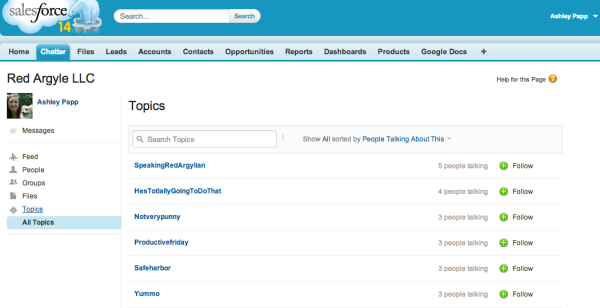 As fate would have it, the moment I started reevaluating Salesforce tags is the moment before they’re due to be replaced by the new Chatter topics functionality. I took some time to look over both Tags and Topics, and I put together a brief overview of what they are, why you might be interested in them, and some of the advantages that Topics are bringing to the game.
As fate would have it, the moment I started reevaluating Salesforce tags is the moment before they’re due to be replaced by the new Chatter topics functionality. I took some time to look over both Tags and Topics, and I put together a brief overview of what they are, why you might be interested in them, and some of the advantages that Topics are bringing to the game.
Your Salesforce Records, Your Way
At their core, Tags and Topics are tools that allow users to create labels for records in the system, and then view records based on those labels later. These labels don’t have to be reflected anywhere else in the data on the record, and can be created by users as-needed without any intervention from an administrator (as opposed to, say, new custom fields or field values). To add a topic you simply type #ExampleTopic.
This flexibility means that users can start organizing and grouping records in any way that makes sense to them. Say someone in research wanted to keep track of who had participated in certain case studies. Or someone in sales wanted to flag certain accounts that seemed positioned for an up-sell. Tags and topics let your users make these notes on the fly, on their own, without any intervention from a Salesforce Administrator.
Salesforce Topics
Salesforce topics offer a few new and welcome changes to the functionality that once was granted by Salesforce tags. The biggest standout feature is that you can now reference topics when creating list views. Users can build views that are filtered based on which topics are on their records, meaning one less page in the system to have to navigate to.
That said, it looks like all Topics in the system are going to be publicly viewable. Tags come in two flavors, public (so visible to everyone in the system) and private (only visible to the person who created them). I’ve always felt that Tags were more appropriate for individual users to organize their records their way. I’m not sure if the intent is that Topics will only replace public Tags, or if everything is moving in a direction towards more visibility.
Things to Consider
Even with the improvements that are coming with Topics, there’s still one bit of functionality I wish was present. Neither Salesforce tags nor Salesforce topics are visible in reports. There’s no way to run data analysis or simple export on records that are grouped by Tags or Topics.
Moreover, I think it’s important to know where to draw the line between a common Topic and a newly required functionality. While trying to think of examples for ways that Topics can be used to organize records, I kept finding I was arguing with myself over whether Salesforce provided a better solution, through the use of custom fields or new relationships. If a data point is important enough that a large number of your users need to access and interact with it, I think that the added admin work of setting it up in the system is well worth the investment.
Final Thoughts
After reviewing these features, I can see the case for private Tags; if a user just wants to organize their things in their way, then private Tags let them do that without having to worry about what other users think of it. And in sufficiently small numbers, Topics make sense as well. But once more than a few users are interested in tracking a given piece of data, I’m still going to lean toward admin-driven configuration work.
If you’ve got some ideas or examples for how Tags and Topics can be used in ways I haven’t thought of, feel free to post in the comments below. I’d love to find some new ways to utilize these features.






